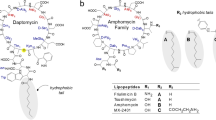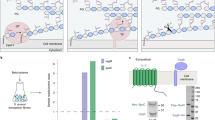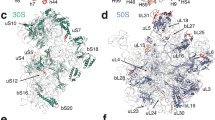Abstract
TEICHOIC acids are strongly acidic polymers containing phosphate, which are present in all Gram-positive bacteria1. They are found at two distinct locations in the cell envelope: associated with a glycolipid on the outer surface of the cytoplasmic membrane2,3 and covalently linked to the peptido-glycan of the cell wall3. The wall teichoic acid is responsible for the ability of the cell walls of Gram-positive bacteria to bind divalent cations4 and the membrane teichoic acid mediates an interaction between magnesium ions, bound to the wall, and the cytoplasmic membrane, thus maintaining the optimum cation environment for the activity of magnesium-dependent biosynthetic enzymes in the membrane5,6. It is therefore important to identify the interactions involved in binding magnesium to teichoic acids in the bacterial envelope; although electrostatic interaction between the cations and negatively charged phosphate groups is a prominent feature, interactions with other components of the envelope cannot be ruled out. For example, the amount of D-alanine esterified to the wall teichoic acid of Staphylococcus aureus H and Micrococcus sp. 24 influences the capacity of these walls to bind Mg2+ (ref. 4).
This is a preview of subscription content, access via your institution
Access options
Subscribe to this journal
Receive 51 print issues and online access
$199.00 per year
only $3.90 per issue
Buy this article
- Purchase on Springer Link
- Instant access to full article PDF
Prices may be subject to local taxes which are calculated during checkout
Similar content being viewed by others
References
Archibald, A. R., and Baddiley, J., Adv. Carbohyd. Chem., 21, 323 (1966).
Coley, J., Duckworth, M., and Baddiley, J., J. Gen. Microbiol. (in the press).
Baddiley, J., Essays in Biochemistry (1972).
Heptinstall, S., Archibald, A. R., and Baddiley, J., Nature, 235, 379 (1972).
Hughes, A. H., Stow, M., Hancock, I. C., and Baddiley, J., Nature New Biology, 229, 53 (1971).
Hughes, A. H., Hancock, I. C., and Baddiley, J., Biochem. J., 132, 83 (1973).
Douglas, L. J., and Wolin, M. J., Biochemistry, 10, 1551 (1971).
Moore, S., and Stein, W. M., J. Biol. Chem., 176, 367 (1948).
Siegbahn, K., Nordling, C., Fahlman, A., Nordberg, K., Hamrin, K., Hedman, J., Johansson, G., Bergmark, T., Karlsson, S.-E., Lindgren, I., and Lindberg, B., ESCA-Atomic Molecular and Solid State Structure Studied by Means of Electron Spectroscopy (Almqvist and Wiksell, Stockholm, 1967).
Archibald, A. R., Baddiley, J., and Heptinstall, S., Biochim. Biophys. Acta, 291, 629 (1973).
Author information
Authors and Affiliations
Rights and permissions
About this article
Cite this article
BADDILEY, J., HANCOCK, I. & SHERWOOD, P. X-ray Photoelectron Studies of Magnesium Ions bound to the Cell Walls of Gram-positive Bacteria. Nature 243, 43–45 (1973). https://doi.org/10.1038/243043a0
Received:
Issue Date:
DOI: https://doi.org/10.1038/243043a0
This article is cited by
-
Interaction of metal ions with poly(1,3-propylene phosphate) ? a synthetic analogue of natural teichoic acids
Colloid & Polymer Science (1994)
-
Hydration of synthetic polydialkylphosphate (PPF) ? a simplified model for natural teichoic acids
Colloid & Polymer Science (1984)
Comments
By submitting a comment you agree to abide by our Terms and Community Guidelines. If you find something abusive or that does not comply with our terms or guidelines please flag it as inappropriate.



